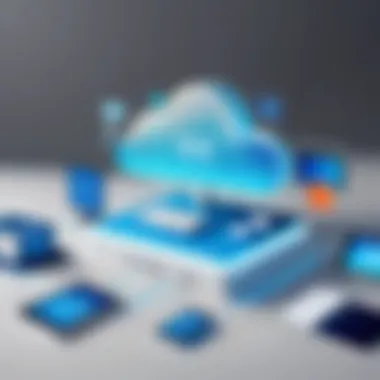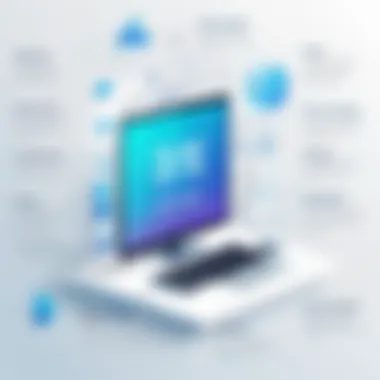Exploring the World of Software as a Service (SaaS)


Intro
Software as a Service (SaaS) stands as one of the most significant advancements in the realm of technology. The rise of cloud computing has redefined how software is delivered, managed, and utilized. SaaS provides an accessible framework, allowing users to organize and operate their applications over the internet without the need for complex installations or hardware demands.
SaaS applications often utilize a subscription-based model, which simplifies expenses for both consumers and businesses. This streamlining makes it easier to budget for resources, thereby increasing project efficiency and allowing for better allocation of financial assets. In this introduction, we delve into the defining qualities of SaaS, its advantages, potential challenges, and the future direction of this model.
By presenting practic http://en.wikipedia.orgal considerations such as integration methods, security measures, and cost analysis, the readers—comprising app developers, tech enthusiasts, and novices aiming to broaden their knowledge—will find rich, applicable insights on SaaS operations. Expect a thorough educational journey through the core concepts and practical insights shaping the SaaS ecosystem today.
App Overview
Understanding SaaS Applications
SaaS applications are built on a foundational principle: they deliver software solutions via a web browser, effectively bypassing traditional installation processes. Users can access these applications through their devices at any location, making it a potent tool for a dynamic work environment.
Some primary inclusive features of SaaS revolve around scalability, reliability, and maintenance-free access.
- Scalability: Organizations can simply adjust their usage based on necessity, whether they are scaling up at peak demand or trimming down.
- Reliability: SaaS comes with robust operational frameworks, ensuring minimal downtime and smooth access across networks.
- Maintenance-Free Access: Providers manage updates and backup processes; this reduces user burden while optimizing function and performance.
With the advent of SaaS, enterprises can vanish excess hardware and software expenses, leading to significant cost savings while reaping enhanced productivity. Additionally, ease of integration with existing tools enables teams to harness their peak functionalities. This sectlion illustrates how SaaS reshapes business practices, proving its relevance in varied organizational contexts.
Key Characteristics of SaaS
SaaS remedies several logistical pain points. Its immediacy lays a surplus of efficiencies at users' fingertips:
- Subscription Pricing Model: Reduces upfront costs and lowers barriers for new enterprises keen on leveraging technology without facing financial dispossession.
- Automated Updates: Providers sort out servers and storage app updates, freeing consumers from routine evolutionary phases.
- Cross-Device Access: Mentioning the predominance of mobile technology; mobility adds an extra layer, allowing team efficacy regardless of geography.
As the market evolves, Awareness of potential limitations is essential. Issues around customization potential or bandwidth frustration whilst employing numerous SaaS solutions combined increase exponentially. Thus, grasping both benefits and obstacles of SaaS lends a holistic insight into its operational effectiveness.
SaaS is pioneering a nuanced digital transformation across industries. As we explore further, an analytical lens will reveal how interaction between these applications and their users threads around advantages, while navigation of their obstacles remains persistently agile.
Definition of SaaS
Understanding Software as a Service (SaaS) is crucial for navigating today's digital ecosystem. SaaS represents a shift in how software is consumed and delivered. In this model, applications are hosted on the cloud and made accessible over the internet. This section will detail the concept, historical context, and key characteristics that make SaaS a significant player in the software industry.
Historical Context
The concept of SaaS evolved from earlier models of software delivery such as timesharing, where multiple users accessed a single system. However, true SaaS began to take shape in the late 1990s. Companies like Salesforce pioneered this model, offering customer relationship management tools without the need for local installations. The rise of high-speed internet connections and advances in cloud computing facilitated SaaS adoption. By offering scalable solutions without significant upfront investments, SaaS quickly gained traction in both large enterprises and startups.
With growth, SaaS has matured into a central model for software distribution. The emphasis on subscription-based licensing has reshaped traditional software economics, so businesses can respond more flexibly to changing needs. Thus, users can rely on maintenance, updates, and support largely handled by the provider. These developments reveal the importance of SaaS, not just as a service, but as an essential strategic asset for many organizations.
Key Characteristics
SaaS is defined by a set of characteristics that distinguish it from traditional software models. These include:
- Cloud-Based Deployment: SaaS operates entirely from a remote service rather than user's own systems. Users access it via web browsers, enabling easier maintenance by the service provider.
- Subscription Pricing: Rather than purchasing a license outright, users typically pay a recurring fee, which can include basic support and updates. This aligns costs more closely with usage.
- Scalability: SaaS solutions can scale with changing user demand. Organizations can add or detract services quickly as business needs evolve.
- Automated Updates and Maintenance: Providers manage upgrades and enhancements, allowing users to access the latest versions without disruptions. This continuous improvement makes SaaS a flexible option for businesses.
- Multi-Tenancy Architecture: Multiple users share a single instance of the software, ensuring efficient use of resources while maintaining data separation. This promotes lower costs and consistency across users.
Understanding these characteristics allows users and developers alike to assess the adaptability of SaaS solutions suited for their requirements.
How SaaS Works
Understanding how Software as a Service (SaaS) operates is essential for any user or developer working in today's tech landscape. Thissection moves beyond definitions, focusing on the architecture that supports SaaS platforms and how they improve user experience. (experiance)
Architecture Overview
SaaS architecture differs notably from traditional software structures. In the SaaS model, software resides on a remote server and is delivered over the internet to users. This architecture usually involves a multi-tenant model, where a single instance of the application serves multiple users. Each tenant’s data remains separate, ensuring security and personalized experiences.
Key components include:


- Client Interface: This is the part users interact with, typically through a web browser or mobile app.
- Application Layer: This executes the program's functionalities and services, hosting the core SaaS solution.
- Data Layer: Here lies the databases and data storage solutions that hold user data, preferences, and operational info.
- Integration Layer: This layer allows the SaaS application to connect to other software or systems, which can enhance functionality and user experience.
In summary, the SaaS architecture enables rapid deployment of updates and seamless integrations, critical factors that many businesses value today.Tasks can be accomplished more quickly since there is no need for users to install or maintain their software version.
User Accessibility
User accessibility is an important feature of SaaS solutions. Unlike traditional software, catered mainly for specific hardware configurations or operating systems, access is flexible in the SaaS environment. Users can generally log in from any device with internet access.
This leads to significant advantages:
- Convenience: Users can manage applications and perform tasks from their home, office, or while traveling.
- Cost Savings: No need for expensive hardware, as the computing power and storage is managed remotely.
- Collaboration: Software often provides tools allowing groups of users to work together on projects in real-time, fostering productivity.
Moreover, as businesses look to improve their digital footprints, the concept of Remote Access becomes more crucial. Applications like Google Workspace offerplaces where documents can be shared, edited, and tracked collaboratively, demonstrating a key aspect of accessibility within SaaS.
Overall, SaaS changes how software interacts with users, focusing on accessibility and ease of use. As we transition deeper into a cloud-centric world, understanding how these systems work influences how organizations choose their technological solutions.
Benefits of SaaS
Understanding the importance of the benefits associated with Software as a Service (SaaS) is critical for both developers and users. SaaS offers unique advantages over traditional software deployment models. Various factors contribute to the appeal of SaaS, including cost, scalability, and maintenance ease. Knowing these benefits can help users make informed decisions and optimize their use of software solutions.
Cost Efficiency
One of the primary drivers behind the popularity of SaaS is the significant cost efficiency it offers. With traditional software, users often need to make a large upfront investment in licenses, hardware, and infrastructure. In contrast, SaaS operates on a subscription model that spreads costs over time. This approach can free up capital for businesses, allowing them to allocate resources more effectively.
SaaS services usually include everything needed, such as maintenance and support. Installation and upgrades are managed by the provider, minimizing the potential extra costs associated with installation and ongoing management. Furthermore, many SaaS applications provide pay-as-you-go pricing options, accommodating the specific needs of various users.
"Cost savings and predictability can significantly enhance cash flow and financial planning for technology-driven organizations."
Scalability
Scalability is another considerable benefit of SaaS architecture. Organizations can easily adjust their usage as needs evolve. This elasticity is ideal for rapidly changing environments because users do not need to invest in additional infrastructure when demand increases. Unlike traditional software, which often faces constraints during upgrades, SaaS can streamline expansion processes very effectively.
When organizations want to add more users or services, they can do so with a few simple clicks. No need for extensive on-premise installations or team reconfigurations. It allows firms to remain agile, making it easier to respond to new market demands and opportunities.
Automatic Updates
When using SaaS, users benefit from automatic updates provided by service providers. This convenience ensures that organizations are always using the latest technology without added burdens. With traditional models, maintaining software versions requires careful planning and coordination to upgrade effectively, often leading to downtime during critical operations.
In a SaaS environment, users can focus on core business functions rather than getting bogged down with management tasks. The service provider handles updates and patches regularly, offering additional time for staff to focus on more pressing issues. This updates process reduces the likelihood of security vulnerabilities caused by neglect or lack of updates on older software versions.
The combination of cost efficiency, scalability, and the convenience of automatic updates makes SaaS an attractive option. Understanding these benefits gives users the insight needed to leverage the model optimally, reinforcing the relevance of SaaS in the modern digital landscape.
Challenges of Implementing SaaS
Implementing Software as a Service (SaaS) presents several key challenges that organizations must navigate. Understanding these challenges is crucial for both users and developers. Addressing issues related to data security, downtime, and integration with existing systems can help maximize the benefits of SaaS, while mitigating potential risks. Below are important considerations in this context.
Data Security Concerns
Data security is a primary concern for any organization considering a shift to SaaS. Since user data is hosted on third-party servers, the risk of unauthorized access or data breaches increases. Weaknesses arise from reliance on external providers, leading to worries replacing data integrity and compliance regulations. Organizations must carefully evaluate the security measures that a SaaS provider implements to safeguard critical data.
To address these concerns, it is wise to choose providers that comply with industry standards such as ISO 27001 and GDPR. Vendor transparency regarding security practices and incident response plans is vital. Ensuring proper encryption, secure key management, and regular security audits can help to minimize vulnerabilities in a SaaS environment. Organizational awareness and education about data privacy are also necessary elements to build trust with customers and end-users.
Downtime and Reliability
Downtime can have a significant impact on operations. While SaaS vendors generally promise reliability, outages can still occur due to server issues or other unexpected situations. Companies must assess the service level agreements (SLAs) of potential vendors to ensure that they guarantee acceptable uptime levels.
Understanding the measures taken by a provider to cope with service disruptions is necessary when selecting a SaaS solution. Some essential tips to consider include:


- Review their historical uptime performance.
- Inquire about redundant systems and backup procedures.
- Check for maintenance windows and how they notify users.
An additional layer of analysis could involve seeking customer reviews. Before committing to a SaaS solution, organizations should try to understand the experiences of others while using the vendor’s services. High levels of analytics will help track and predict reliability, thereby affecting decision-making processes.
Integration with Existing Systems
Integration is another challenge that must be managed closely while deploying a SaaS model. Many companies operate on a mix of legacy systems alongside newer platforms. Aligning methods will take thorough planning and execution. Incompatible interfaces or varying technologies can impede seamless integration, leading to reduced efficiency.
SaaS solutions need to communicate effectively with existing tools and processes. Effective strategies to deal with integration challenges include:
- Conduct compatibility assessments on current systems.
- Engage with the SaaS vendor about available APIs for smooth interactions.
- Develop an execution plan that includes timelines and responsibilities.
Ultimately, comprehensive and systematic planning is essential. Successful integration can streamline workflows and enhance productivity, making it a pivotal consideration when harnessing the flexibility of SaaS in any organization.
Through understanding the challenges and directly addressing them, organizations stand to fully benefit from the advantages provided by Software as a Service.
SaaS vs.
Traditional Software Models
The differentiation between SaaS and traditional software models holds great significance in today's digital landscape. Users and organizations often grapple with the choice of software delivery methods that best fits their needs. With its intrinsic characteristics, SaaS introduces benefits that resonate well with modern usage scenarios, whilst traditional software models maintain their relevance in specific contexts.
To navigate the complexities of technology, understanding how these paradigms align with user expectations and business requirements is crucial.
Comparison of Cost Structures
When speaking of cost, the dissimilarities between SaaS and traditional models become palpable. Traditional software usually demands hefty upfront costs. Users or organizations must purchase licenses and often pay additional fees for installation and maintenance. These factors contribute to significant initial investments before the software is even operational.
In contrast, SaaS operates on a subscription basis, resulting in a pay-as-you-go model. By opting for regular monthly or annual contributions, users gain access to the software with lesser direct financial burdens at the start. This model promotes flexible budgeting and reduces risks associated with large upfront investments.
Furthermore, available features in on-premises, traditional software might require additional purchases.
Here are a few points comparing costs:
- SaaS: lower initial cost, ongoing subscription fees, flexible payment plans.
- Traditional Software: high upfront cost, single purchase, substantial savings over prolonged use possible only if used as intended.
Understanding these structures influences decision-making for companies considering infrastructure and software options, equipping them to align financial practices with operational strategies.
User Experience Differences
The user experience is another critical differentiator when evaluating SaaS against traditional software models. SaaS applications frequently prioritize usability and accessibility, overcoming limitations barring business functionality.
For instance, users access SaaS applications via web browsers, rewarding them with the flexibility of using almost any device connected to the internet. This simplicity often bolsters user engagement and adoption, a point that traditional software can struggle with, especially considering system requirements and installation demands.
In the case of user interface design, SaaS platforms frequently update their interfaces based on user feedback. They embrace contemporary design paradigms and focus on mobile optimization, crucial due to the proliferation of smartphones. Traditional software, though powerful, can lag in user experience enhancement, requiring significant manual updates for improvements.
Consider these points regarding differences in user experience:
- SaaS: ease of access on multiple devices, remote use, regular feedback-driven updates.
- Traditional Software: typically requires installation, can be inflexible with versions and updates, less emphasis on mobile use.
By focusing on user needs and preferences, SaaS represents a responsive evolution of service models that enhances everyday usage and business operations.
Overall, the distinctions between SaaS and traditional software as models encompasses a breadth of considerations. Recognizing these aspects is essential for developers and users when making software decisions, adopting the best available tools to maximize efficiency and productivity.
Industry Applications of SaaS
SaaS has transformed how various industries operate, enabling numerous businesses to adopt cloud-based solutions that state significant advantages. The practical application of this model extends across sectors like education, healthcare, and business operations. Understanding these applications allows stakeholders to make informed choices while leveraging the inherent flexibility and cost savings the SaaS model offers.


SaaS in Education
The use of SaaS in education has increasingly gained traction. Schools, colleges, and universities benefit immensely from software systems delieverd over the cloud. Online learning platforms such as Google Classroom and Microsoft Teams are just two examples that arole up significant trends.
Not only does SaaS facilitate an effective learning environment, but it also streamlines administrative tasks. Teaching staff can manage homework submission, track students' performance, and even facilitate parent-teacher communication from a centralized platform. This efficiency cuts down administrative time, allowing educators to focus more on teaching. Moreover, it creates a more scalable infrastructure, enabling institutions to adjust to the rising demands in a cost-effective manner.
SaaS in Healthcare
The healthcare sector utilizes SaaS for several mission-critical applications. Solutions like Epic Systems and Athenahealth illustrate how cloud-based software can manage patient data and streamline processes. Electronic health records (EHRs) improve the accuracy of patient information and enhance sharing among healthcare providers.
Adopting SaaS fosters compliance with regulations, as providers can maintain updated security features that protect sensitive patient data. Furthermore, telemedicine applications powered by SaaS broaden access for patients and facilitate better healthcare delivery. Healthcare institutions appreciate the scalability of SaaS, which allows rapid deployment of new features without significant investments in hardware.
SaaS in Business Operations
SaaS provides extensive applications in business operations. Tools such as Salesforce for customer relationship management and Slack for internal communication demonstrate the model's capabilities in enhancing productivity and collaboration.
Businesses employing SaaS can quickly adapt to market demands and adjust their tools to match operational needs. By switching to a subscription-based model, companies alleviate initial capital expenditures, choosing instead to align their software costs with actual usage. These efficiencies empower organizations to focus on their core business strategies while relying on robust SaaS solutions to optimize their operational frameworks.
Leveraging SaaS, organizations gain competitive advantages through increased efficiency, streamlined processes, and access to advanced tools without the burden of extensive initial investments.
In summary, SaaS applications are widely relevant across various sectors, transforming traditional models and setting new standards for efficiency, scalability, and adaptability.
The Future of SaaS
The landscape of Software as a Service is shifting, influenced by technological advancements and evolving user demands. Understanding the future of SaaS is essential for developers, businesses, and tech-savvy users. This area offers insights into what to expect and how SaaS will adapt to meet upcoming needs.
Emerging Trends
In the rapidly changing world of SaaS, several trends are emerging that signify its future direction. These trends inlcude:
- Increased Demand for Customization: Users are seeking more personalized solutions. The SaaS providers who support extensive customization options will likely thrive.
- Integration of Advanced Technologies: The incorporation of technologies like blockchain and Internet of Things (IoT) is becoming common. This integration provides enhanced functionality and security.
- Rise of Industry-Specific Solutions: As specific industry needs become more acute, software tailored for niche markets will gain traction. SaaS companies that focus on specialized verticals can create a competitive advantage.
- Shift Towards Multi-Cloud Strategies: Organizations are beginning to adopt multi-cloud approaches to diversify risks and enhance flexibility. This means SaaS providers must ensure compatibility across various cloud environments.
This multifaceted approach highlights the increasingly intricate and layered nature of the SaaS industry.
Impact of AI and Automation
Artificial intelligence and automation are not just trends but revolutionizing the SaaS terrain. They bring numerous benefits, including
- Enhanced Efficiency: Through automation, SaaS tools can streamline repetitive tasks, saving time for users and companies.
- Improved User Experience: AI can personalize user interactions and offer proactive support through chatbots and predictive analytics.
- Data-driven Insights: AI tools can analyze vast amounts of data swiftly, allowing SaaS providers and businesses to make informed decisions.
Combining AI with traditional SaaS platforms creates new opportunities for users and developers alike. The integration invites a more interactive experience with software while enhancing operational choice and responsiveness in the marketplace.
The future of SaaS hinges on both understanding emerging trends and leveraging innovations like AI to drive success and adaptability.
Ending
The conclusion serves as the final synthesis of the invaluable insights presented throughout the article. It condenses critical informaiton and primes the reader for practical applications. A well-structured conclusion in the context of Software as a Service (SaaS) emphasizes the importance of understanding this model, particularly for app developers and tech-savvy users and beginners either looking for guidelines in various applications or a deep dive into user experience considerations.
Recap of Key Points
In this article, several fundamental components of SaaS have been discussed. These include:
- Definition and Characteristics: The nature of SaaS as a delivery model for software is unique. It operates using the cloud, where multiple users access software applications through the internet.
- Benefits: The cost efficiency of the SaaS model makes it favorable for many organizations. Scalability is another critical benefit enabling businesses to grow without significant overhead.
- Challenges: Despite its benefits, there are inherent challenges. Data security remains a high concern, and integrating existing systems can sometimes be complex and time-consuming.
- Future Directions: As technology evolves, embracing trends like AI and automation indicates a promising path left in the exploration of SaaS dynamics.
This crisp summary allows easy reference to major themes and concepts at play in SaaS.
Final Thoughts on SaaS
SaaS stands as a transformative element in the software industry, signaling a shift from traditional software deployments to a more agile cloud-focused approach. Its relevance continues to expand across diverse industries such as education, healthcare, and complex business operations. Developers and users alike must understand SaaS intricately.
The adaption of SaaS technologies often leads to improved user experiences and streamlined operations. However, businesses must be prudent regarding security concerns with sensitive data in play. Overall, embracing SaaS can foster innovation while ensuring scalability and flexibility in a competitive landscape.
"Software as a Service revolutionizes access to critical apps, empowering teams ready to embrace flexibility while latently confronting inherent challenges."
Recognizing the fine balance between its benefits and potential issues, people must stay updated in a rapidly shifting digital ecosystem. A finish line is not visible yet; the journey is only beginning.







